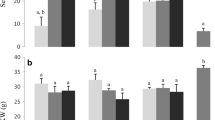Abstract
This study was conducted to investigate the impact of wheat gluten protein degradation during storage in a dough and bread system due to different levels of fungal contamination with F. culmorum. Therefore, artificially infected grains were stored in a model system and analysed for their gluten content and quality. This revealed a substantial loss in wet gluten content and a weakening of the gluten network in the infected samples during storage. Subsequently, the samples were used to bake wholegrain breads and the obtained dough and breads were analysed. Reduced quality as a consequence of storage was found for all samples, but in the infected samples to a greater extent than in the healthy grains. The breads presented a reduced quality, mainly due to their high bake loss, deformed loaf shape and open crumb structure. The reason for these results was mainly found to be due to the increased enzymatic activities originating from the fungal metabolism. Furthermore, the deterioration of the bread quality after storage was independent of the level of initial infection. Consequently, this study demonstrates the importance of optimal storage conditions and the development of efficient methods to suppress fungal proliferation during storage, in order to reduce economic losses and ensure a consistent high quality of the resulting products.


Similar content being viewed by others
References
USDA (2013) Agricultural marketing service: grain and oilseed shipment sizes and distances hauled by rail. United States Department of Agriculture. Foreign Agricultural Service, Washington, DC
McGee H (2004) On food and cooking: the science and lore of the kitchen. Scribner, New York, p 517
Clark B, Bryson R, Tonguç L, Kelly C, Jellis G (2012) The encyclopedia of cereal diseases. 889 HGCA/BASF. http://www.hgca.com. Accessed 05 Dec 2014
Schmidt M, Horstmann S, DeColli L, Danaher M, Speer K, Zannini E, Arendt EK (2016) Impact of fungal contamination of wheat on grain quality criteria. J Cereal Sci 69:95–103
Pitt J, Hocking AD (2009) Fungi and food spoilage, 3rd edn. Springer, London
Oliveira PM, Mauch A, Jacob F, Waters DM, Arendt EK (2012) Fundamental study on the influence of Fusarium infection on quality and ultrastructure of barley malt. Int J Food Microbiol 156:32–43
AACC International. Approved methods of analysis (1995) Method 38-12.02. Wet gluten, dry gluten, water-binding capacity, and gluten index. Approved November 3, 1999, 11th edn. AACC International, St. Paul. doi:10.1094/AACCIntMethod-38-12.02
GlutoPeak Test procedure (2016) Brabender, Duisburg, Germany http://www.brabender.com/english/food/products/quality-control/baking-conditions/glutopeakr.html. Accessed 01 Nov 2016
Dunnewind B, Janssen AB, Van Vliet T, Weenen H (2004) Relative importance of cohesion and adhesion for sensory stickiness of semisolid foods. J Texture Stud 35:603–630
AACC International (1995) Approved Methods of analysis. Method 54-21.02. Rheological behavior of flour by farinograph: constant flour weight procedure. Approved November 3, 1999, 11th edn. AACC International, St. Paul. doi:10.1094/AACCIntMethod-54-21.02
Perten Glutomatic “About Gluten” (2016) Perten instruments. http://www.perten.com/Products/Glutomatic/About-gluten/. Accessed 01 Nov 2016
Kieffer R, Wieser H, Henderson MH, Graveland A (1998) Correlations of the breadmaking performance of wheat flour with rheological measurements on a micro-scale. J Cereal Sci 27:53–60
Wang J, Wieser H, Pawlezik E, Weinert J, Keutgen AJ, Wolf GA (2005) Impact of the fungal protease produced by Fusarium culmorum on the protein quality and breadmaking properties of winter wheat. Eur Food Res Technol. doi:10.1007/s00217-004-1112-1
Biliaderis CG, Izydorczyk MS, Rattan O (1995) Effect of arabinoxylans on bread-making quality of wheat flours. Food Chem 53:165–171
Tester RF, Qi X, Karkalas J (2006) Hydrolysis of native starches with amylases. Animal Feed Sci Technol 130:39–54
Dexter JE, Clear RM, Preston KR (1996) Fusarium head blight: effect on the milling and baking of some Canadian wheats. J Cereal Chem 73(6):695–701
Nightingale MJ, Marchylo BA, Clear RM, Dexter JE, Preston KR (1999) Fusarium head blight: effect of fungal proteases on wheat storage proteins. J Cereal Chem 76(1):150–158
Koehler P, Hartmann G, Wieser H, Rychlik M (2007) Changes of folates, dietary fibre, and proteins in wheat as affected by germination. J Agric Food Chem 55:4678–4683
Meyer D, Weipert D, Mielke H (1986) Effects of Fusarium culmorum infection on wheat quality. Getreide Mehl Brot 40:35–39
Mei N, McDaniel L, Dobrovolsky V, Guo X, Shaddock JG, Mittelstaedt RA, Azuma M, Shelton S, McGarrity L, Doerge D, Heflich R (2010) The genotoxicity of acrylamide and glycinamide in big blue rats. Toxicol Sci 115(2):412–421
Koehler P, Wieser H (2013) Chemistry of cereal grains. In: Gobetti M, Gaenzle M (eds) Handbook on sourdough technology. Springer, New York, pp 11–46
Bråthen E, Knutsen SH (2005) Effect of temperature and time on the formation of acrylamide in starch-based and cereal model systems, flat breads and bread. J Food Chem 92:693
Acknowledgements
Financial support for this research was awarded by the Irish Government under the National Development Plan 2007–2013 through the research programme FIRM/RSF/CoFoRD. This research was also partly funded by the Irish Department of Agriculture, Food and the Marine.
Author information
Authors and Affiliations
Corresponding author
Ethics declarations
Conflict of interest
The authors declare that they have no conflict of interest.
Compliance with ethics requirements
This article does not contain any studies with human or animal subjects.
Electronic supplementary material
Below is the link to the electronic supplementary material.
Rights and permissions
About this article
Cite this article
Schmidt, M., Zannini, E. & Arendt, E.K. Impact of post-harvest degradation of wheat gluten proteins by Fusarium culmorum on the resulting bread quality. Eur Food Res Technol 243, 1609–1618 (2017). https://doi.org/10.1007/s00217-017-2869-3
Received:
Revised:
Accepted:
Published:
Issue Date:
DOI: https://doi.org/10.1007/s00217-017-2869-3



